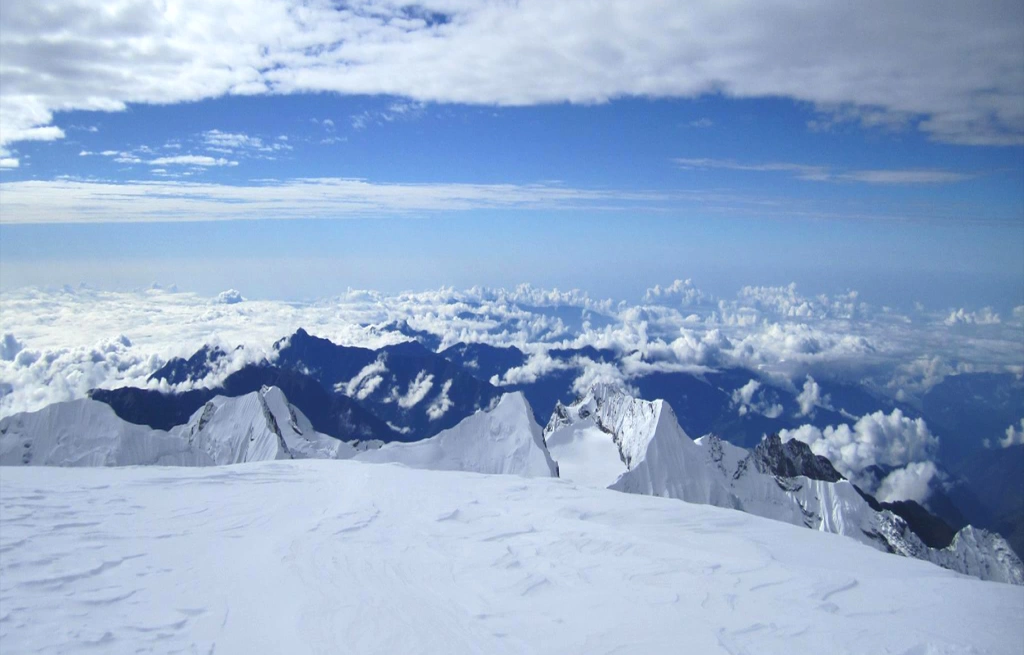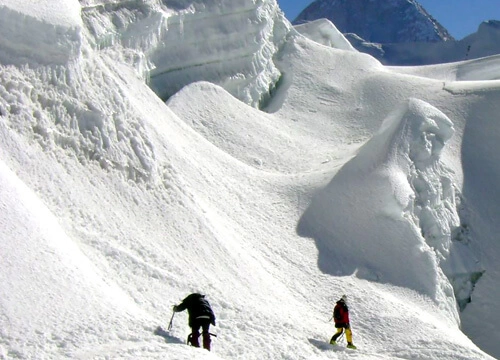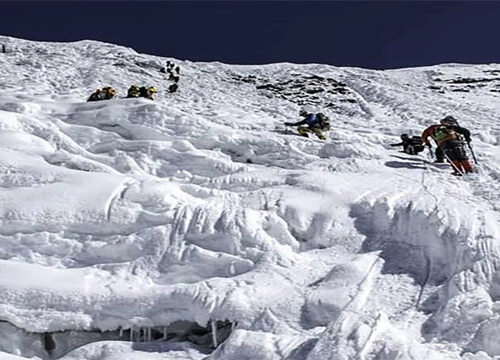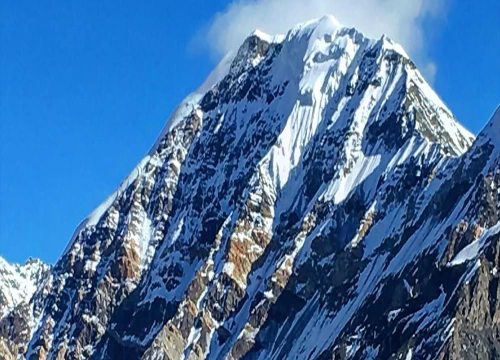Mera Peak Climbing takes you to Mera Peak, a spectacular free-standing mountain and one of the highest trekking peaks in the world. An expedition famous for its diverse experience to the climbers, Mera Peak climbing combines the pleasure of mountain trekking, rich Sherpa culture, and its heritage, as well as the exploration of the seldom, visited yet truly marvelous landscapes on the edge of Khumbu region. In a tough yet rewarding experience, trekkers pursue their dream of Mera Peak climbing by traversing through varieties of vegetation, sparsely inhabited Hinku valley and less-visited sanctuary of Makalu Barun National Park, high passes and graze lands, small streams, lush and green hills, and valleys, glaciers and glacial streams and rocky terrain. Besides, the Sherpa settlements en route and beautiful views of Himalayas add beauty to this experience.
Mera Peak Climbing begins with a spectacular flight to Lukla over high hills and with the view of fascinating mountains beside spectacular landscapes. Trekking down from Lukla, we shall traverse through dense forest, traditional villages, and terraced hills and enjoy the view of Kongde Ri, Khatang and other peaks above 7000 meters to reach the settlement of Paiya. Ahead in the trail we cross the pass of Kari La Hill and explore the rhododendron, pine and bamboo forests, trek past Mani walls and through steep trails to reach the vantage point of Hinku valley from where we march ahead along the ridge and to the summer settlement of Gondishung.
Ahead in this Mera Peak Climbing, we shall pay the visit to the 200-year-old Lungsumgba Gompa we continue ahead to summer grazing area of Tangnag before walking on the glacial moraines to the snout of glaciers near Khare. Navigating through the boulder-strewn and steep trail we reach to the base camp of Mera Peak and after preparation, climbers reach to summit of the peak via High Camp. The magnificent views of majestic Everest, Cho Oyu, Lhotse, Makalu, Ama Dablam, Kanchenjunga, and several other peaks are visible from the summit of Mera Peak. After accomplishing this feat in our Mera Peak Climbing, we shall gradually follow the trail back to Lukla and then to Kathmandu to complete this adventure.
Mera Peak Climbing is a challenging pursuit to the highest trekking peak in Nepal and requires the climbers to have basic experience of ice ax and crampons, and of course proper physical fitness enough to pursue a strenuous walk and peak climbing. September to December and March to May are the best season for Mera Peak climbing. Get our professional service with experienced climbing guides, carefully planned itinerary with sufficient acclimatization days and comfortable accommodation as possible in the field.
Climbing begins with a spectacular flight to Lukla over high hills and with the view of fascinating mountains beside spectacular landscapes. Trekking down from Lukla, we shall traverse through dense forest, traditional villages, and terraced hills and enjoy the view of Kongde Ri, Khatang and other peaks above 7000 meters to reach the settlement of Paiya. Ahead in the trail we cross the pass of Kari La Hill and explore the rhododendron, pine and bamboo forests, trek past Mani walls and through steep trails to reach the vantage point of Hinku valley from where we march ahead along the ridge and to the summer settlement of Gondishung.
Ahead in this Mera Peak Climbing, we shall pay the visit to the 200-year-old Lungsumgba Gompa we continue ahead to summer grazing area of Tangnag before walking on the glacial moraines to the snout of glaciers near Khare. Navigating through the boulder-strewn and steep trail we reach to the base camp of Mera Peak and after preparation, climbers reach to summit of the peak via High Camp. The magnificent views of majestic Everest, Cho Oyu, Lhotse, Makalu, Ama Dablam, Kanchenjunga, and several other peaks are visible from the summit of Mera Peak. After accomplishing this feat in our Mera Peak Climbing, we shall gradually follow the trail back to Lukla and then to Kathmandu to complete this adventure.
Mera Peak Climbing is a challenging pursuit to the highest trekking peak in Nepal and requires the climbers to have basic experience of ice ax and crampons, and of course proper physical fitness enough to pursue a strenuous walk and peak climbing. September to December and March to May are the best season for Mera Peak climbing. Get our professional service with experienced climbing guides, carefully planned itinerary with sufficient acclimatization days and comfortable accommodation as possible in the field.



